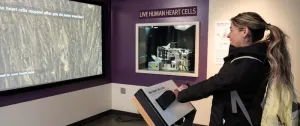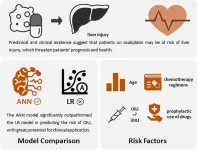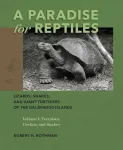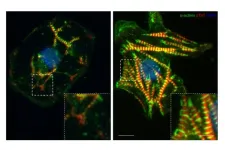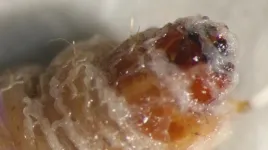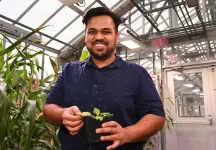(Press-News.org) One of the country’s best-known science museums, San Francisco’s Exploratorium, is located less than three miles north of Gladstone Institutes—a proximity that has resulted in creative, high-science collaborations like the permanent exhibit featured in the latest issue of Stem Cell Reports.
Among the museum’s most popular exhibits, “Give Heart Cells A Beat” opens a rare window into the microscopic world of the beating human heart, using technology and materials made possible through Gladstone’s science and expertise. With the exhibit, the team created the first interactive museum experience that allows the public to interact directly with living cardiomyocytes, or heart muscle cells.
“It’s like having a lens into yourself because these same types of cells are within us—it’s an incredible experience for our visitors,” says Kristina Yu, PhD, senior director of science R&D for the Exploratorium.
As visitors approach the exhibit, a projected video displays beating heart cells—as many as 200,000—on an oversized monitor. Visitors hold onto handlebar sensors in front of the screen and feel their pulse through their hands. Then, within seconds, they watch as the heart cells on the screen begin beating in sync with their own heart.
“The juxtaposition of the very small cells in the dish with a very large image on the screen is quite powerful,” Yu says.
Bruce Conklin, MD, a senior investigator at Gladstone, has been collaborating with Yu and others at the Exploratorium for more than 15 years, well before the exhibit opened in 2019. In fact, the idea for the heart exhibit came from a scientist in Conklin’s lab—and it began with a seemingly simple question: Would it be possible to take beating heart cells from the lab and find a way to synchronize them with the hearts of visitors?
“We’re always searching for a natural phenomenon that enables a visitor to have an immediate experience with something alive,” Yu says. “That’s incredibly difficult to do at scale, which is why this idea just cried out to be done—even though we knew it would be incredibly difficult.”
Yu and Conklin, along with their respective teams, share their experience launching and running the heart beat exhibit in a new study that appears in Stem Cell Reports. To their knowledge, it’s the first interactive museum exhibit to use live human heart cells—which, in this case, are derived from adult skin cells and then developed into heart cells at Gladstone using stem cell technology.
“By sharing our experience in such detail, we hope the exhibit will serve as a model that inspires future relationships between academia and public science venues all over the world,” Conklin says. “We’ve been able to create a very powerful and relatable experience that sparks discussion about the heart and health, as well as stem cell science.”
The Heart of the Exhibit
Through interviews with museum visitors who interacted with the exhibit, the Exploratorium found that 90% reported thinking more about their own hearts, 30% remarked on the technology behind the exhibit, and 20% specifically mentioned stem cells. In addition, visitors engaged longer with the heart-cell exhibit than they did with the 37 other exhibits, the journal article says.
Importantly, visitors also get to learn how the exhibit works: They’re taught that their heart rate is sent as an electrical signal from the handlebar sensors to a lab dish that holds living heart cells, located behind a window a few feet away. When the cells receive the signal, they begin pacing in beat with the visitor’s heart. Written cues on the monitor encourage visitors to increase or lower their heart rate to see how the cells react, or to invite a friend to use the handlebars to compare heart rates.
“It’s always fun to watch visitors’ reactions,” Yu says. “We see them doing jumping jacks and running in place to elevate their heart rate, which quickly translates within the video image. The best thing is when they gesture to their friends to come over and try the experience themselves.”
She says it requires much less explanation than other types of biological phenomena because our heart beat is something we experience our whole life: “Although you’ll never get a chance to look at your own living heart cells, you feel them every day. This exhibit allows visitors to have an electrical dialog with these cells.”
Despite numerous challenges, not the least of which is keeping heart cells alive in a dish for many months at a time, it turns out that heart cells are unique in their ability to interact with visitors.
“Heart cells have a dynamic behavior in real time, which is beating, and they can respond to external signals,” explains Juan Perez-Bermejo, PhD, a former postdoctoral fellow in Conklin’s lab who played a key role in developing the exhibit. He is also first author of the new study. “No other cells can do this in a way that could be the center of an exhibit.”
Stem Cell Science in Action
Indeed, the underlying science that makes the exhibit possible is nothing short of prizeworthy.
Gladstone Senior Investigator Shinya Yamanaka, MD, PhD, pioneered the technology that enables scientists to reprogram adult cells into an embryonic state. Known as induced pluripotent stem cells—or iPSCs—these cells have the ability to develop into any kind of cell in the body. They’re the basis for the fast-growing field of regenerative medicine, and their tremendous potential for transforming medicine earned Yamanaka the 2012 Nobel Prize in Physiology or Medicine.
The human heart cells in the Exploratorium exhibit were once skin cells. Using Yamanaka’s technology, Gladstone scientists reprogrammed them in the lab to become iPSCs, then prompted them to grow into a different type of cell: cardiomyocytes, or heart muscle cells.
Conklin’s team often uses tissue created from the skin cells of patients who carry disease mutations and study the tissues in the lab to better understand what causes cardiovascular disease and how to treat it. The cells in the exhibit are left over from experiments, and because they were developed for specific research purposes, cannot be used for other studies.
“Our goal was to take a phenomenon like beating heart cells and craft an amazing, wow-inducing activity that allows someone with no biological knowledge to make a connection with the biological world,” Yu says.
It’s not just the visitors who relish the wonder of interacting with living heart cells. Conklin admits to experiencing a thrill each time he peers into the dish.
“At first, when you look at them, you don’t see anything going on because your eye doesn’t know where to look,” he explains. “But once you see one area of movement, you spot others, and you realize these heart cells are beating and you get a chill up your spine. It’s really a magical moment that conveys the excitement of scientific discovery.”
Possible Through Partnership
Human cell lines are extremely susceptible to contamination, so caring for them requires very specific skills and expertise. Conklin credits the highly skilled staff at the Exploratorium for making the exhibit a success.
“Not every museum could do this,” he says. “There’s a lot of work that goes into maintaining these cells, keeping them healthy and alive, but the Exploratorium actually has trained PhDs in molecular biology on staff. They’ve been tremendous partners.”
The person responsible for looking after the cells in the exhibit is Dana Carrison-Stone, biologist and laboratory manager at the Exploratorium. She says that after the heart cells beat for a few months, they need to be replaced with new cells. Luckily, Gladstone is nearby.
“The easiest way is to bike over,” says Carrison-Stone, an author of the study. “I pack a Styrofoam container with dry ice, put it in my backpack, hop on my bike and ride over to Gladstone, where I meet one of the scientists. They take me to the liquid nitrogen tanks where the cells are stored; I pick up a replacement batch, put it in my backpack, and ride back to the Exploratorium to begin the thaw process.”
The close collaboration between Gladstone and the museum makes the exhibit possible, she adds: “We wouldn’t be able to have this exhibit without Gladstone. The scientists are always there if I have questions or need help troubleshooting or problem solving.”
Gladstone scientists also help by sharing creative concepts for exhibits and helping the Exploratorium showcase leading science that will engage the general public.
“Big ideas for a museum exhibit often come from places like Gladstone,” Yu says. “The scientists suggest what is on the cutting edge of scientific frontiers and we think about how that can be translated into a visitor experience. Then we work together to see how to make it happen. Gladstone provides resources, expertise, and deep knowledge that we really lean on, so we can create a really amazing experience for the public.”
About the Study
The paper, “Give heart cells a beat: an interactive museum exhibit that synchronizes stem cell-derived cardiomyocytes to visitors’ heartbeat,” was published in the journal Stem Cell Reports on February 8, 2024. In addition to Bruce Conklin, Kristina Yu, Juan Perez-Bermejo, and Dana Carrison-Stone, authors include: Samuel Reisman, Joyce Ma, and Chris Cerrito of the Exploratorium, and Alexandre Ribeiro of Gladstone.
About Gladstone Institutes
Gladstone Institutes is an independent, nonprofit life science research organization that uses visionary science and technology to overcome disease. Established in 1979, it is located in the epicenter of biomedical and technological innovation, in the Mission Bay neighborhood of San Francisco. Gladstone has created a research model that disrupts how science is done, funds big ideas, and attracts the brightest minds.
About the Exploratorium
The Exploratorium is a portal to the astonishing scientific phenomena that animate our world and shape our actions. It creates extraordinary learning experiences that ignite curiosity, upend perceptions, and inspire brave leaps forward. Since 1969, the Exploratorium has been home to a renowned collection of exhibits that draw together science, art, and human perception, changing the way science is taught. Its award-winning programs provide a forum for the public to engage with artists, scientists, policymakers, educators, and tinkerers to explore the world around them. The Exploratorium celebrates diversity of thought, inspired investigation, and collaboration across all boundaries.
END
Heart-to-heart connection: Exploratorium and Gladstone bring a breakthrough science exhibit to life
At San Francisco’s Exploratorium, visitors sync their heartbeat with living heart cells; the first-of-its-kind exhibit was created through the museum’s long-running partnership with scientists at Gladstone Institutes.
2024-02-08
ELSE PRESS RELEASES FROM THIS DATE:
Predictive model of oxaliplatin-induced liver injury based on artificial neural network and logistic regression
2024-02-08
Since 2004, several clinical studies have reported that patients with OXA frequently experienced adverse effects of liver injury (LI), typically characterized by hepatic sinusoidal injury, splenomegaly, decreased platelet count and noncirrhotic portal hypertension, which can progress to nodular regenerative hyperplasia with long-term treatment. LI also decreased hepatic functional reserve and aggravated the postoperative course of colorectal cancer patients after hepatectomy, and may affect intraoperative bleeding, postoperative morbidity, and overall survival. LI can ...
The Galapagos comes to life in new RIT Press book
2024-02-08
Natural scientist and author Robert Rothman takes readers on a reptillian tour of the Galápagos Islands in his new book, A Paradise for Reptiles: Lizards, Snakes, and Giant Tortoises of the Galápagos Islands Vol. 1: Tortoises, Geckos, and Snakes, published by RIT Press.
For more than 30 years, Rothman has led hundreds of Rochester Institute of Technology students on tours to the Galápagos Islands to observe the wildlife and landscape that inspired Charles Darwin’s theory of evolution by natural selection. Rothman’s A Paradise for Reptiles, an homage to the 19th century scientist, is an accessibly written guide for anyone interested in Darwin, the Galápagos, ...
Social media can reveal who needs the most help
2024-02-08
Language use in social media can be a useful tool for social scientists, because it reflects living conditions in areas the posts originate from.
“There is a correlation between social inequalities and language patterns in social media,” says Associate Professor Lucas M. Bietti at the Norwegian University of Science and Technology (NTNU’s) Department of Psychology.
Researchers studied 30 million X/Twitter posts from the United States. They compared the language used in the tweets to the living conditions in the counties from which the ...
Clues to cancer drug’s deadly side effects could make it safer
2024-02-08
For some leukemia patients, the only potential chemotherapy option is a drug that also carries a high risk of heart failure. This means that some patients who recover from their cancer will end up dying of heart disease brought on by the cure.
In a new study, researchers from the University of Illinois Chicago and other universities have identified mechanisms that cause the drug, ponatinib, to harm the heart. They also identified a promising treatment that could reverse this process. The paper, with senior author Sang Ging Ong, assistant professor of pharmacology and medicine at UIC, is published in Circulation Research. The study is part of a growing field called cardio-oncology ...
Surprise discovery of tiny insect-killing worm
2024-02-08
UC Riverside scientists have discovered a tiny worm species that infects and kills insects. These worms, called nematodes, could control crop pests in warm, humid places where other beneficial nematodes are currently unable to thrive.
This new species is a member of a family of nematodes called Steinernema that have long been used in agriculture to control insect parasites without pesticides. Steinernema are not harmful to humans or other mammals and were first discovered in the 1920s.
“We spray trillions of them on crops every year, and they’re ...
Are environmental toxins putting future generations at risk?
2024-02-08
In a study that signals potential reproductive and health complications in humans, now and for future generations, researchers from McGill University, the University of Pretoria, Université Laval, Aarhus University, and the University of Copenhagen, have concluded that fathers exposed to environmental toxins, notably DDT, may produce sperm with health consequences for their children.
The decade-long research project examined the impact of DDT on the sperm epigenome of South African Vhavenda and Greenlandic ...
Protecting the protector boosts plant oil content
2024-02-08
UPTON, NY—Biologists at the U.S. Department of Energy’s (DOE) Brookhaven National Laboratory have demonstrated a new way to boost the oil content of plant leaves and seeds. As described in the journal New Phytologist, the scientists identified and successfully altered key portions of a protein that protects newly synthesized oil droplets. The genetic alterations essentially protect the oil-protector protein so more oil can accumulate.
“Implementing this strategy in bioenergy or oil crop plants could ...
Physical activity is insufficient to counter cardiovascular risk associated with sugar-sweetened beverage consumption
2024-02-08
Québec, February 8, 2024 - Contrary to popular belief, the benefits of physical activity do not outweigh the risks of cardiovascular disease associated with drinking sugar-sweetened beverages, according to a new study led by Harvard T. H. Chan School of Public Health. Jean-Philippe Drouin-Chartier, professor at Université Laval’s Faculty of Pharmacy, was a co-author.
Sugar-sweetened beverages are the largest source of added sugars in the North American diet. Their consumption is associated with ...
CARB-X funds Visby Medical to develop a portable rapid diagnostic for gonorrhea including antibiotic susceptibility
2024-02-08
(BOSTON: Thursday, February 8, 2024) – Combating Antibiotic-Resistant Bacteria Biopharmaceutical Accelerator (CARB-X) will award up to US$1.8 million to biotechnology company, Visby Medical, to develop a portable rapid polymerase chain reaction (PCR) diagnostic to detect the presence of the pathogen that causes gonorrhea, Neisseria gonorrhoeae (NG), and its susceptibility to ciprofloxacin, a former frontline oral antibiotic that can no longer treat resistant NG. A rapid result on when ciprofloxacin may be effective could enable physicians to treat gonorrhea patients with confidence, while reserving ceftriaxone, the only antibiotic that remains effective against resistant NG.
Visby ...
Fusion research facility JET’s final tritium experiments yield new energy record
2024-02-08
GARCHING and OXFORD (8 February 2024) –
The Joint European Torus (JET), one of the world’s largest and most powerful fusion machines, has demonstrated the ability to reliably generate fusion energy, whilst simultaneously setting a world-record in energy output.
These notable accomplishments represent a significant milestone in the field of fusion science and engineering.
In JET's final deuterium-tritium experiments (DTE3), high fusion power was consistently produced for 5 seconds, resulting in a ground-breaking record of 69 megajoules using a mere 0.2 milligrams of fuel.
JET is a tokamak, a design which uses powerful ...
LAST 30 PRESS RELEASES:
Numbers in our sights affect how we perceive space
SIMJ announces global collaborative book project in commemoration of its 75th anniversary
Air pollution exposure and birth weight
Obstructive sleep apnea risk and mental health conditions among older adults
How talking slows eye movements behind the wheel
The Ceramic Society of Japan’s Oxoate Ceramics Research Association launches new international book project
Heart-brain connection: international study reveals the role of the vagus nerve in keeping the heart young
Researchers identify Rb1 as a predictive biomarker for a new therapeutic strategy in some breast cancers
Survey reveals ethical gaps slowing AI adoption in pediatric surgery
Stimulant ADHD medications work differently than thought
AI overestimates how smart people are, according to HSE economists
HSE researchers create genome-wide map of quadruplexes
Scientists boost cell "powerhouses" to burn more calories
Automatic label checking: The missing step in making reliable medical AI
Low daily alcohol intake linked to 50% heightened mouth cancer risk in India
American Meteorological Society announces Rick Spinrad as 2026 President-Elect
Biomass-based carbon capture spotlighted in newly released global climate webinar recording
Illuminating invisible nano pollutants: advanced bioimaging tracks the full journey of emerging nanoscale contaminants in living systems
How does age affect recovery from spinal cord injury?
Novel AI tool offers prognosis for patients with head and neck cancer
Fathers’ microplastic exposure tied to their children’s metabolic problems
Research validates laboratory model for studying high-grade serous ovarian cancer
SIR 2026 delivers transformative breakthroughs in minimally invasive medicine to improve patient care
Stem Cell Reports most downloaded papers of 2025 highlight the breadth and impact of stem cell research
Oxford-led study estimates NHS spends around 3% of its primary and secondary care budget on the health impacts of heat and cold in England
A researcher’s long quest leads to a smart composite breakthrough
Urban wild bees act as “microbial sensors” of city health.
New study finds where you live affects recovery after a hip fracture
Forecasting the impact of fully automated vehicle adoption on US road traffic injuries
Alcohol-related hospitalizations from 2016 to 2022
[Press-News.org] Heart-to-heart connection: Exploratorium and Gladstone bring a breakthrough science exhibit to lifeAt San Francisco’s Exploratorium, visitors sync their heartbeat with living heart cells; the first-of-its-kind exhibit was created through the museum’s long-running partnership with scientists at Gladstone Institutes.
